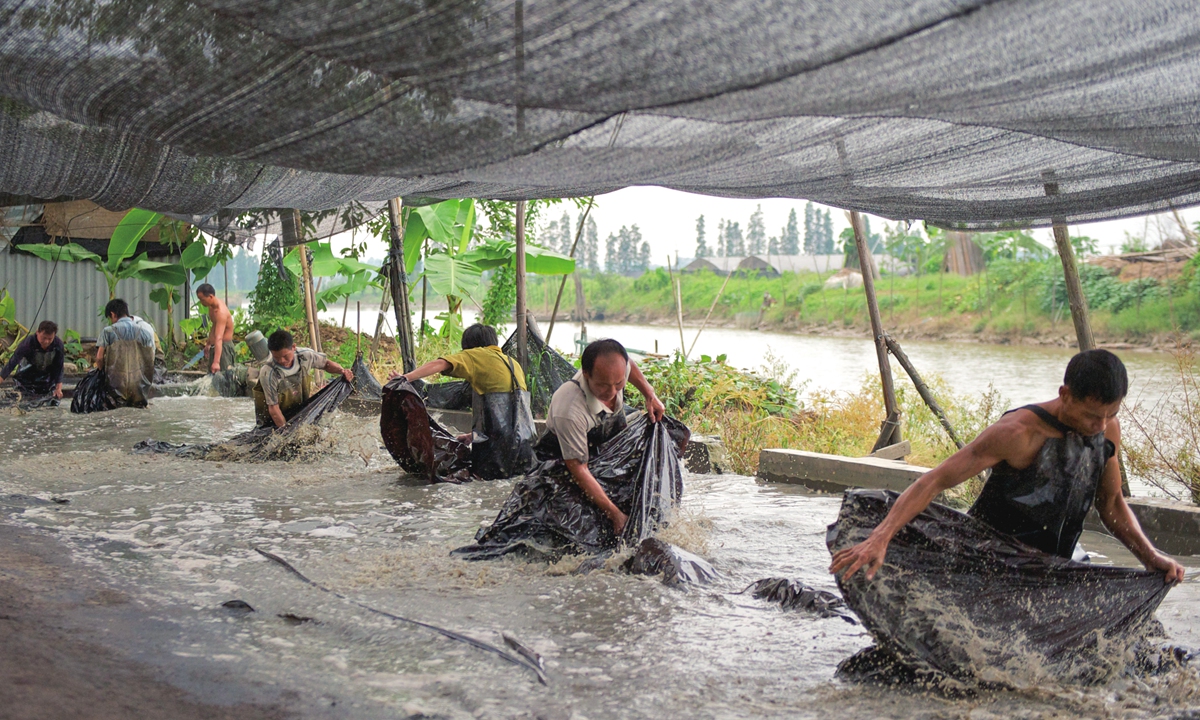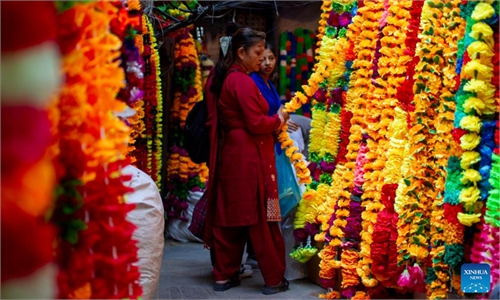ARTS / ART
German designer explores China's centuries-old silk fabric tradition
Taking a shine to it

The "Wuwei" collections by fashion designer Kathrin von Rechenberg Photo: Courtesy of Kathrin von Rechenberg

Designer Kathrin von Rechenberg Photo: Courtesy of Kathrin von Rechenberg

Silk makers wash mud out of xiangyunsha fabric in Foshan, Guangdong Province. Photo: Courtesy of Kathrin von Rechenberg
German fashion designer Kathrin von Rechenberg built her studio inside a quiet hutong (traditional alley) in the southern part of central Beijing. Over 20 years ago, the Munich-born fabric lover made up her mind to travel to Beijing to seek out a rarely seen fabric that can only be found in China: xiangyunsha, or Tea Silk, a shiny metallic-looking type of silk which once almost completely disappeared from the public eye.
Showing off one of the silk collections she is most proud of, Von Rechenberg, who has been awarded with the title as Friendship Ambassador for Textile Intangible Cultural Heritage in 2020, explained that making Tea Silk is an extensive process.
The iron in the mud reacts chemically with the silk and causes the gauze to be metallic black on one side and brown on the other.
Von Rechenberg was studying in Paris when she began seeing traditional Chinese silk in a brand new light.
In 1995, Von Rechenberg first became acquainted with xiangyunsha when a friend from the island of Taiwan wore attractive dresses made from the soft and ethereal natural fabric to school.
"It has this anti-bacterial feature which prevents it from rotting. And when the material is put in the river it turns black. This intrigued me," she said, adding that she flew to Beijing in 2000 in order to find this extremely traditional handicraft after having worked at various haute couture fashion houses. While in Beijing, she met Zhang Xiangyun, her future husband.
The two headed south looking for the origin of the fabric.
River power
Every year during the warm season in the southern part of China, xiangyunsha artisans start the busiest period for producing silk.
During the hottest days in Shunde district of Foshan, Guangdong Province, hundreds of workers wearing bamboo hats move back and forth as they spread out hundreds of meters of silk fabric to be exposed to the sun.
"You need to see the weather forecast ahead of time to find continuous sunny days. Normally we need six sunny days in total. We really must avoid sudden rain, otherwise it will be a disaster," said Chen Hongfa, a silk maker in Shunde who has been working in this industry for more than 30 years.
The fabric is traditionally made in places along the southern reaches of South China's Pearl River Delta. Formed by the accumulation of river sediment, the Pearl River Delta is the largest alluvial plain in southern China and its soil is rich in minerals.
In Shunde, where the well-known famous "egret paradise" wetlands are located, the secluded, lush forest that covers around 16 soccer fields has, as local workers believe, the best mud for making the shiny fabric.
The extremely complicated process, which involves more than 20 steps, can be summed up into two major parts: First, dyeing the fabric repeatedly with tannin rich red-and yellow-colored shuliang and then exposing it to the sun.
Second, covering the fabric with iron-rich mud and waiting for the chemical reaction to complete.
Since 2014, Chinese pioneering new art musician Gong Linna has worn Von Rechenberg's clothing, made of pure natural dyes such as shuliang root, indigo and pomegranate peels, during her concerts to go with their one-with-nature theme.
There are many explanations concerning the origin of xiangyunsha. Some local workers say that it began in the Qing Dynasty (1644-1911) and some say that the technique to make the fabric was used as early as the Ming Dynasty (1368-1644). What is certain is that during the 1920s and 1930s, this metallic-looking fabric became trendy in cities such as Shanghai and Foshan.
Ancient wisdom
The complex process endows Tea Silk with an elegant quality full of Chinese characteristics that made it popular overseas as well.
To date, this fabric is still only produced by local workers in southern China.
Von Rechenberg said what attracted her most is not its rarity but the concepts conveyed by the fabric: classic simplicity bundled with concepts of sustainability birthed from the wisdom of ancient Chinese.
This harmony with nature greatly appealed to her since she has seen the negative side of the fast fashion industry's mass production methods.
"In order to pursue efficiency, many merchants ignored the truest side of this ancient Chinese material, and instead make ones to follow the mass trend. However, they bring certain environmental pollution as well which is against the value the fabric has conveyed since its beginning," Von Rechenberg said.
"It would be a pity to ignore the respect for nature in traditional Chinese culture at any rate," she added.




